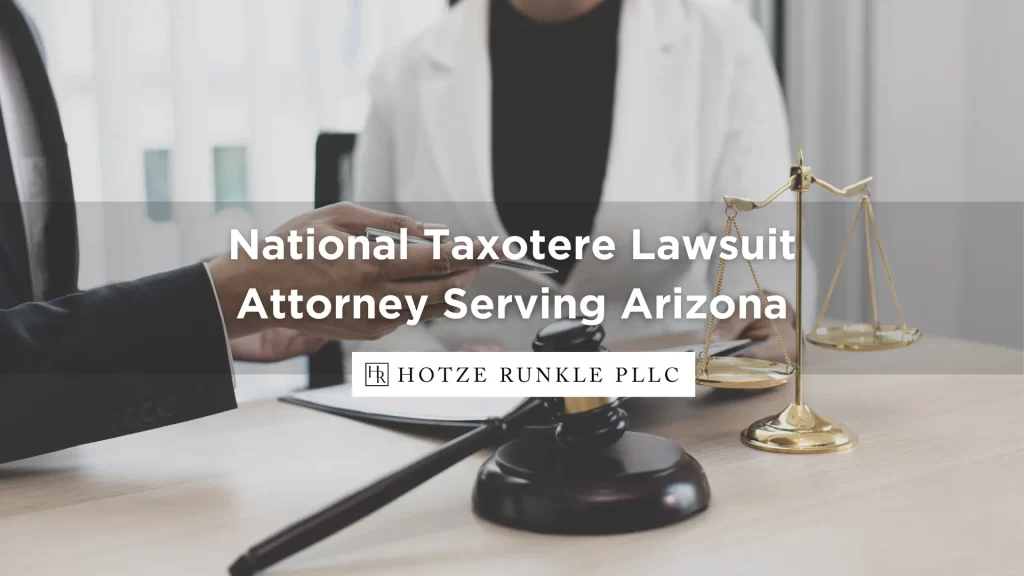
Did you or a loved one experience severe side effects impacting your eyes as a result of the chemotherapy drug, Taxotere? If so, the Arizona Taxotere canalicular stenosis attorneys want to hear from you right away.
Recent medical research shows the dangerous link between Taxotere and canalicular stenosis. The widely-used chemotherapy drug, used mainly in the treatment of breast cancer, is effective in shrinking cancer cells and preventing them from spreading throughout the body. However, cancer survivors diagnosed with Canalicular Stenosis, a debilitating ocular condition, brought attention to Taxotere’s dangerous side effects.
Multi-billion dollar pharmaceutical company, Sanofi-Aventis, created Taxotere for the use in treating various forms of cancer. It works by attacking abnormal, cancerous cells in the body and shrinking them. It’s proven useful in treating cancer of the breast, prostate, stomach, lung, head, and neck.
Individuals battling breast cancer first started noticing adverse reactions to the drug during their treatments. It begins with epiphora, which is excessive eye-watering, and often develops into the more severe diagnosis of Canalicular Stenosis. Common symptoms include:
- Excessive tears
- Consistent eye-watering
- Headaches
- Light sensitivity
- Eye infections
- Eyelid swelling
- Vision loss
- Blurry or cloudy vision
- Dry eyes
As canalicular stenosis progresses, it causes permanent, irreversible damage to vital structures of the eye. There’s no cure for this condition, and efforts to manage symptoms are invasive and expensive.
Early intervention of watery eyes by an ophthalmologist is crucial. With the proper diagnosis and treatment, epiphora symptoms are manageable with eye drops or a topical ointment.
Did Taxotere Cause My Canalicular Stenosis Symptoms?
In the beginning stages, epiphora (watery eyes) typically presents in cancer patients undergoing Taxotere treatment. A physician administers the chemo drug intravenously once a week or every three weeks. The regimen of doses isn’t at all dependent on whether or not symptoms appear.
Studies showed the interactions between Taxotere and an individual’s body fluids. As the drug travels through the body, secretions come in direct contact with a person’s tears. The secretions mix with the tears as they get funneled through the canaliculus into the nasal cavity.
An adverse reaction causes inflammation of this vital part of the ocular cavity. When chronic inflammation occurs, it often leads to an infection. If left untreated, the infection obstructs the canaliculus, blocking tears from traveling through, as intended. With nowhere else to go, the tears have no choice but to get pushed out of the eye.
Diagnosing epiphora is difficult because most ophthalmologists are unaware of the symptoms that Taxotere causes. Additionally, many breast cancer patients assume it’s just a side effect of the chemo that will eventually pass. However, medical researchers published articles proving the drug leads to side effects associated with epiphora and Canalicular Stenosis.
To most people, the symptoms seem relatively harmless. However, to those experiencing them, it’s incredibly debilitating. It affects a person’s ability to perform routine tasks and participate in activities they once enjoyed. Simple things like driving a car, reading, or applying makeup seem like a chore when the symptoms occur.
How is Sanofi-Aventis Responsible for Taxotere’s Side Effects?
Like most pharmaceutical drugs, Taxotere causes unruly symptoms. It hardly seems like cause for a lawsuit, right? Wrong. It’s incredibly careless when drug companies don’t disclose possible side effects. Current lawsuits state that Sanofi knew about the risks, but failed to reveal them. Instead, they misled distributors and consumers in their marketing campaigns.
For years, Sanofi-Aventisreleased the results of experiments showing how effective Taxotere is at treating cancer above other popular chemo drugs. However, it wasn’t until researchers published papers about the harmful side effects that the manufacturer finally created warning labels about epiphora and canalicular stenosis.
Drug companies like Sanofi-Aventis are responsible for disclosing the potential side effects of their products to doctors and patients. When they fail to warn people adequately, it doesn’t allow anyone to choose alternative treatments. Cancer patients didn’t receive all the information necessary to decide what course of treatment is best for them. That’s a severe injustice that deserves financial compensation.
Is There a Cure for Canalicular Stenosis?
There’s currently no cure for canalicular stenosis. In the beginning, when only epiphora symptoms are present, it’s possible to treat excessive eye-watering with the use of eye drops. A topical steroid is also useful in reducing any inflammation of the canaliculus.
Consistent treatment and visits to an ophthalmologist could aid in preventing a diagnosis of canalicular stenosis. However, chronic inflammation causes a blockage in the canaliculus that leads to partial or complete closure. When the canaliculus closes, it’s impossible to reverse.
An invasive and expensive procedure called DCR, dacryocystorhinostomy is a possible solution to the problem. It redirects tears around the obstructed canaliculus and into the nasal cavity. During the surgery, the physician places a stent that creates a new passageway to funnel tears and prevent them from exiting the eyes.
If performed successfully, DCR effectively manages canalicular stenosis symptoms. In cases where one or both canaliculi are damaged so severely that DCR isn’t an option, the surgeon could perform CDCR (conjunctivodacryocystorhinostomy). CDCR requires the placement of a glass tube called a Jones tube where the canaliculus was. Like DCR, it allows tears to pass through and travel towards the nasal passages.
Undergoing any surgical procedure is a risk, and DCR and CDCR are no exceptions. The possible side effects patients experience include:
- Excessive bleeding during and after surgery
- Significant facial scarring
- Further eye infections
- Damage to tissues surround the canaliculus
- Partial or total blindness
- The body’s rejection of the stent or Jones tube
- Ineffective procedure
- Sinusitis
If you’re interested in finding relief from your symptoms, you should consult with your ophthalmologist. He or she will inform you of all the risks and help you decide which option is right for you. In extreme situations, surgery isn’t possible, and you face living with your diagnosis indefinitely.
What Should I Do If Took Taxotere and Experienced Negative Side Effects?
There are several essential steps you need to take if you developed any symptoms of Canalicular Stenosis after undergoing treatment with Taxotere.
- Notify your oncologist
- Get an evaluation by an ophthalmologist
- Take detailed notes about your symptoms, when they started, and how they affect your daily routine
- Request copies of your medical records
- Hire a lawyer from Hotze Runkle PLLC
Seeking legal representation is crucial. An experienced Arizona Taxotere attorney knows how to prove negligence in a product liability case. When you retain Hotze Runkle PLLC’s services, we will immediately start working on your case. We’ll gather crucial evidence that proves your chemo treatment resulted in your symptoms.
Fighting against big pharma is overwhelming for anyone without legal experience. When you have Hotze Runkle PLLC by your side, we’ll handle all aspects of your case for you. You won’t have to go through this alone. We dedicate our time and attention to ensuring our clients receive the maximum settlement available.
Why Do I Need a Lawyer?
 An attorney from Hotze Runkle PLLC understands what to do when seeking compensation from pharmaceutical companies like Sanofi-Aventis. Suing any person or entity requires following strict deadlines and submitting appropriate documentation. If you’ve never filed a lawsuit before, it’s impossible to do it alone.
An attorney from Hotze Runkle PLLC understands what to do when seeking compensation from pharmaceutical companies like Sanofi-Aventis. Suing any person or entity requires following strict deadlines and submitting appropriate documentation. If you’ve never filed a lawsuit before, it’s impossible to do it alone.
A statute of limitations is the time limit for bringing legal action against another party. In the state of Arizona, product liability cases follow a two-year statute. That means you only have two years from your canalicular stenosis diagnosis or onset of symptoms to file suit against Sanofi. If the two years pass, you lose your right to pursue compensation.
In any lawsuit, you could claim specific damages. Damages are losses suffered as a result of an accident or injury. There are three distinct categories: economic, noneconomic, and punitive. Under Arizona law, you could seek compensation from Sanofi-Aventis for the following:
- Medical expenses
- Lost wages
- Pain and suffering
- Emotional distress
- Loss of consortium
- Death benefits
There are limits to the damages you could claim that affect the amount of your financial award. It’s also a requirement to prove Taxotere directly caused your symptoms as opposed to a previous condition or accident.
How Can an Arizona Taxotere Lawsuit Attorney from Hotze Runkle PLLC Help Me?
At Hotze Runkle PLLC, we believe in fighting for our clients so they receive full and fair settlement for the harm they’ve suffered. We have extensive experience handling product liability lawsuits in Arizona and throughout the United States. Our goal will be to get you the compensation and justice you deserve and to send a message to the pharmaceutical companies that consumers deserve to be warned of potentially life-long side effects from the medication they are given.
We provide free consultations for all prospective clients. If you need legal advice, we’ll schedule an appointment for you to meet with one of our dedicated Taxotere lawsuit attorneys. There’s no risk or obligation to speak with us and receive guidance during this challenging time in your life.
If you believe you or your loved one’s chemo treatment caused your symptoms, take the Taxotere Lawsuit Quiz to see if you have a solid case.